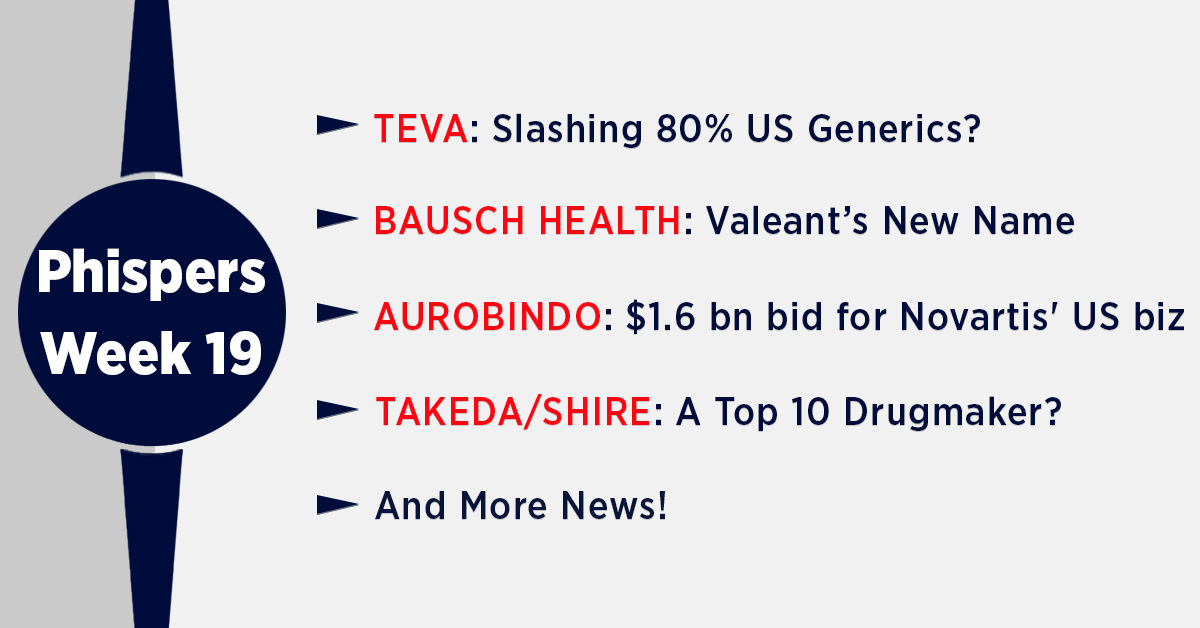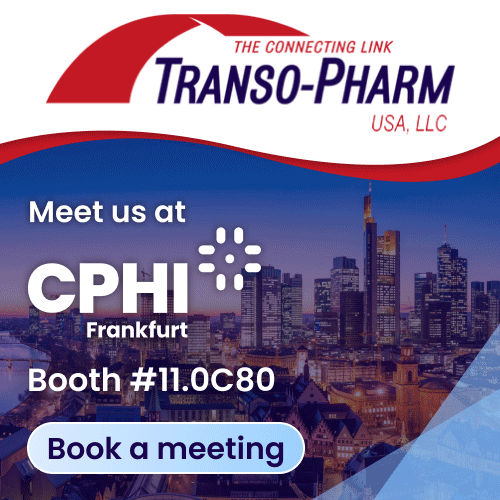
By PharmaCompass
2018-05-10
Impressions: 6402
This week in Phispers, we report on the biggest deal of 2018 yet — Takeda’s acquisition of Shire — that would create a top 10 drugmaker. Teva announced it will exit 80 percent of its US generic portfolio and increase prices of the remaining 20 percent drugs. India’s Aurobindo Pharma submitted its initial bid to buy Novartis’ dermatology generics drug business. Portola bagged FDA nod for its bleeding antidote — Andexxa. And as America awaits President Trump’s speech on drug prices, Celgene said it would re-file its application for ozanimod with the FDA.
Takeda-Shire
deal set to close and create a top 10 drugmaker
This week, Japanese drugmaker Takeda Pharmaceutical agreed to buy London-listed Shire for US$ 62 billion (£45.3 billion) in the biggest deal that has swept the drug industry this year.
If the deal wins the backing of its shareholders, this would be the largest overseas purchase by a Japanese company. The deal would make Takeda one of the 10 largest drug companies in the world.
Led by a French CEO — Christophe Weber — the new entity would be a Japanese national champion in pharmaceuticals and a leader in gastroenterology, neuroscience, oncology, rare diseases and blood-derived therapies, used for serious conditions such as hemophilia.
Weber became Takeda’s first non-Japanese CEO in 2015 and has been hunting for acquisitions in order to make the company more global.
However, buying Shire is a financial stretch for Takeda — it will make Takeda one of the most indebted drugmakers. In fact, due to the size of the deal, Standard & Poor’s had warned of a potential credit downgrade.
To pay off debts quickly, Takeda plans to slash thousands of jobs and cut back on duplicated drug research. According to Endpoints News, Takeda will axe 6 to 7 percent of the combined workforce. With about 30,000 staffers at Takeda and 22,000 at Shire, a 7 percent cutback would mean a loss of about 3,640 jobs.
Is the US generics market ready for Teva’s 80/20 shock therapy?
Last week, Teva posted better-than-expected first quarter results. Though Teva reported a 10 percent decline in its revenues at US$ 5.1 billion, it beat analyst estimates of US$ 4.8 billion.
This left Teva's investors pleasantly surprised. However, during Teva’s earnings call, the new CEO Kåre Schultz made it clear that the US has become a semi-commoditized market and if Teva competes on price, then it will be destroying its own profitability. According to Schultz, Teva is not in the business of just supplying “more and more volume for the sake of the volume”.
As a result, Teva has worked out an 80/20 rule wherein it has decided to slash its US generics portfolio by 80 percent to arrest the slide in profitability in that market. It has reached out to its distributors with a proposal to withdraw around 80 percent of products identified as unviable. For the remaining 20 percent, Teva is asking for a higher price from the distributors.
The 80/20 rule is part of Teva’s US$ 3 billion cost-cutting plan that includes job cuts, plant closures and massive downsizing of its R&D program. During the earnings call, Teva also announced it is on track to lay off 14,000 employees.
Teva’s market share in the US generic prescriptions market is 15 percent. Therefore, with Teva exiting 80 percent of its products, we wonder if Teva’s 80/20 rule is an opportunity for the other generic producers who have been struggling due to severe pricing pressure.
Take the case of Indian drugmakers. Other than Teva’s huge debt problem, Indian generic drugmakers operating in the US are grappling with the same set of challenges — such as falling drug prices, increased competition and consolidation of the big drug-purchasing groups that give them more pricing power versus manufacturers. It will be worth watching how other generic players cash in on the opportunity left behind by Teva.
Aurobindo submits US$ 1.6 billion bid to buy Novartis’ dermatology generics business
Last year, we had reported how Swiss drugmaker Novartis is considering selling off its dermatology business, which is likely to be valued between US$ 1 billion and US$ 1.5 billion.
According to a report published in the Mint, Indian drugmaker Aurobindo Pharma has submitted an initial bid to buy Novartis AG’s dermatology generics drug business for about US$ 1.6 billion.
Novartis’ dermatology generic business includes an array of dermatology brands, production facilities and associated infrastructure, mostly in the US. Novartis is selling off this business, which is under the Sandoz brand, as it is less profitable.
Aurobindo is the only Indian company that has put in a bid for the assets, a report quoted sources as saying. The last date for placing binding bids is June 15.
If the deal goes through, this will be the biggest outbound transaction by an Indian drugmaker, the previous largest one being Lupin’s acquisition of Gavis Pharmaceuticals and Novel Laboratories for US$ 880 million in 2015. Once complete, for the Indian drugmaker this will be the second overseas acquisition in less than two years. In January last year, it agreed to buy Portugal’s Generis Farmaceutica SA from Magnum Capital Partners for US$ 160.3 million.
Portola bags FDA nod for its bleeding antidote Andexxa
American biotech firm Portola Pharmaceuticals has recently won the US Food and Drug Administration (FDA) approval for a potential blockbuster drug.
In mid-2017, this emerging commercial-stage biotech had won the FDA nod for Bevyxxa, an anticoagulant used in acutely ill patients. And last week, its potential blockbuster drug Andexxa won the FDA approval.
Andexxa is a bleeding antidote for some of the new generation blood thinners such as Xarelto and Eliquis. Portola will launch Andexxa next month, although initial supplies will be limited.
Andexxa is the first and the only antidote for life-threatening or uncontrolled bleeding in patients who take blood thinners made with rivaroxaban and apixaban.
The drug uses a novel approach, and in its trials, it was able to reverse greater than 90 percent of the anticoagulant activity of the bestselling drugs such as Johnson & Johnson’s Xarelto and Bristol-Myers Squibb and Pfizer’s Eliquis.
Xarelto and Eliquis were among the top 15 best selling drugs in 2017.
US awaits Trump’s speech on drug prices; GoodRx claims it saved US$ 5 billion for buyers
For long, the US President Donald Trump has been talking about lowering drug prices. In March, he had said: “Drug prices will fall very substantially in the not-too-distant future. And it’s going to be beautiful.”
According to a White House spokesperson, Trump will deliver a speech about lowering prescription drug prices on Friday (May 11).
Trump, who has said drug companies are “getting away with murder” when it comes to charging consumers high prices for drugs, has delayed the speech at least twice. He had made lowering of drug prices a key issue during his 2016 presidential campaign. However, his administration and the US Congress have so far not delivered any meaningful changes.
Pharma biggies, on the other hand, have been pouring in money into a lobbying campaign to foil any serious efforts to rein in prescription drug prices ahead of Trump’s May 11 speech. According to data compiled by the Center for Responsive Politics, an independent group that tracks money in politics, drugmakers spent US$ 171.5 million lobbying the federal government last year — more than any other industry.
“There is apprehension across the industry,” Bruce Artim, former director of federal affairs at Eli Lilly and Company, said. “Pharma folks are nervous.”
Consumers, on the other hand, are quite likely to back Trump. A recent poll by the Kaiser Family Foundation found that 80 percent of Americans believe drug costs are unreasonably high.
The Trump administration’s drug pricing policy will include a “framework” to dismantle rules and restrictions that “shield parts of the drug industry from more vigorous competition,” FDA Commissioner Scott Gottlieb said last week, according to a report published in BioCentury.
Gottlieb said the plan will include “changes to the pricing mechanisms in [Medicare] Part D.” These changes, he added, will create “profound modernization of the program” that will “put us more firmly on a footing to defend the idea that brisk competition should be the vehicle by which we seek to lower drug costs.”
Meanwhile, Doug Hirsch, the co-founder of GoodRx, said in a blog that his company has found many ways to help Americans reduce the cost of prescriptions. GoodRx is a website and mobile app that tracks prescription drug prices and offers drug coupons in the US.
“Recently, we took a few minutes to add up the amount of money people have saved using GoodRx. We’re proud to report that as of April 2018, Americans have saved more than US$ 5 billion with GoodRx (US$ 5.6 billion, to be exact),” Hirsch said.
Celgene to re-file ozanimod application with FDA in early-2019
In late February, the US FDA had rejected Celgene’s regulatory filing for ozanimod in treating multiple sclerosis (MS). Celgene’s application for approval was missing key information.
Since then, Celgene has been working overtime to calm down its anxious investors, and is planning to re-file ozanimod with the FDA in early 2019.
Celgene executives say researchers undertook some bridging non-clinical studies of the drug. And they concluded that no lengthy human studies would be required. Therefore, the delay in refiling is only until early-2019. And Celgene would also file a European application along with the FDA one in the first few months of next year.
Ozanimod was supposed to be launched this year. However, now it seems it won’t hit the market before 2020. That would give competing medicines more time to establish themselves.
Ozanimod is a central part of Celgene CEO Mark Alles’ contention that the company has a bright future. Alles has lined up new deals, such as buying Juno for US$ 9 billion and analysts say Celgene has little margin for error now.
Price-gougers in news: Valeant to become Bausch Health;
Concordia announces refinance deal
The murky relationship between Valeant and now-defunct specialty pharmacy Philidor is all set to play out in the US courts.
Former executive of Valeant — Gary Tanner — is said to have received nearly US$ 10 million in kickbacks through shell companies and shell bank accounts after Valeant purchased Philidor, a deal he helped coordinate.
Tanner and former Philidor CEO Andrew Davenport face charges of honest services wire fraud, money laundering and more. Their trial started recently. In 2016, the duo was charged with using their companies for personal gain at the expense of shareholders.
Valeant Pharmaceuticals International also said it will change its name to Bausch Health Companies Inc. as it seeks to distance itself from a series of scandals and accounting issues under the drug company’s previous management.
Chief executive Joseph Papa has worked for the past two years to turn around the company’s fortunes and regain investor confidence post the investigations into its accounting and pricing practices. Valeant will take on the new name in July this year.
Meanwhile, another price gouging firm Concordia was in news last week as it announced a refinancing deal. The pharma company inked a deal with bulk of its creditors to raise capital of US$ 586 million in a private placement, gain US$ 1.4 billion of new debt, and rework its debt load to reduce it to US$ 2.4 billion.
Through this refinance deal, Concordia will save about US$ 171 million on interest. With the fresh funds and savings, the company will pay its employees, and pay up its bills for now. And in the long term, look at shareholder benefits.
The PharmaCompass Newsletter – Sign Up, Stay Ahead
Feedback, help us to improve. Click here
Image Credit : #Phisper Infographic by SCORR MARKETING & PharmaCompass is licensed under CC BY 2.0
“ The article is based on the information available in public and which the author believes to be true. The author is not disseminating any information, which the author believes or knows, is confidential or in conflict with the privacy of any person. The views expressed or information supplied through this article is mere opinion and observation of the author. The author does not intend to defame, insult or, cause loss or damage to anyone, in any manner, through this article.”








